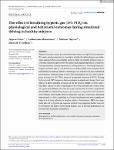The effect of breathing hypoxic gas (15% FIO<sub>2</sub>) on physiological and behavioral outcomes during simulated driving in healthy subjects
| dc.contributor.author | Kaur, J | |
| dc.contributor.author | Manokaran, L | |
| dc.contributor.author | Thynne, M | |
| dc.contributor.author | Subhan, MMF | |
| dc.date.accessioned | 2024-03-25T17:54:12Z | |
| dc.date.available | 2024-03-25T17:54:12Z | |
| dc.date.issued | 2024-03 | |
| dc.identifier.issn | 2051-817X | |
| dc.identifier.issn | 2051-817X | |
| dc.identifier.uri | https://pearl.plymouth.ac.uk/handle/10026.1/22222 | |
| dc.description.abstract |
<jats:title>Abstract</jats:title><jats:p>Hypoxia is mainly caused by cardiopulmonary disease or high‐altitude exposure. We used a driving simulator to investigate whether breathing hypoxic gas influences driving behaviors in healthy subjects. Fifty‐two healthy subjects were recruited in this study, approved by the Science and Engineering Ethical Committee. During simulated driving experiments, driving behaviors, breathing frequency, oxygen saturation (SpO<jats:sub>2</jats:sub>), and heart rate variability (HRV) were analyzed. Each subject had four driving sessions; a 10‐min practice and three 20‐min randomized interventions: normoxic room air (21% FIO<jats:sub>2</jats:sub>) and medical air (21% FIO<jats:sub>2</jats:sub>) and hypoxic air (equal to 15% FIO<jats:sub>2</jats:sub>), analyzed by repeated measures ANOVA. Driving behaviors and HRV frequency domains showed no significant change. Heart rate (HR; <jats:italic>p</jats:italic> < 0.0001), standard deviation of the RR interval (SDRR; <jats:italic>p</jats:italic> = 0.03), short‐term HRV (SD1; <jats:italic>p</jats:italic> < 0.0001), breathing rate (<jats:italic>p</jats:italic> = 0.01), and SpO<jats:sub>2</jats:sub> (<jats:italic>p</jats:italic> < 0.0001) were all significantly different over the three gas interventions. Pairwise comparisons showed HR increased during hypoxic gas exposure compared to both normoxic interventions, while SDRR, SD1, breathing rate, and SpO<jats:sub>2</jats:sub> were lower. Breathing hypoxic gas (15% FiO<jats:sub>2</jats:sub>, equivalent to 2710 m altitude) may not have a significant impact on driving behavior in healthy subjects. Furthermore, HRV was negatively affected by hypoxic gas exposure while driving suggesting further research to investigate the impact of breathing hypoxic gas on driving performance for patients with autonomic dysfunction.</jats:p> | |
| dc.format.extent | e15963- | |
| dc.format.medium | ||
| dc.language | en | |
| dc.publisher | Wiley | |
| dc.subject | driving behavior | |
| dc.subject | healthy subjects | |
| dc.subject | heart rate variability | |
| dc.subject | hypoxia | |
| dc.subject | hypoxic gas | |
| dc.subject | stimulated driving performance | |
| dc.subject | Humans | |
| dc.subject | Healthy Volunteers | |
| dc.subject | Altitude | |
| dc.subject | Autonomic Nervous System Diseases | |
| dc.subject | Hypoxia | |
| dc.subject | Syndactyly | |
| dc.title | The effect of breathing hypoxic gas (15% FIO<sub>2</sub>) on physiological and behavioral outcomes during simulated driving in healthy subjects | |
| dc.type | Journal Article | |
| plymouth.author-url | https://www.ncbi.nlm.nih.gov/pubmed/38439737 | |
| plymouth.issue | 5 | |
| plymouth.volume | 12 | |
| plymouth.publisher-url | http://dx.doi.org/10.14814/phy2.15963 | |
| plymouth.publication-status | Published | |
| plymouth.journal | Physiological Reports | |
| dc.identifier.doi | 10.14814/phy2.15963 | |
| plymouth.organisational-group | |Plymouth | |
| plymouth.organisational-group | |Plymouth|Faculty of Health | |
| plymouth.organisational-group | |Plymouth|Users by role | |
| plymouth.organisational-group | |Plymouth|Users by role|Current Academic staff | |
| plymouth.organisational-group | |Plymouth|Faculty of Health|School of Biomedical Sciences | |
| dc.publisher.place | United States | |
| dcterms.dateAccepted | 2024-02-20 | |
| dc.date.updated | 2024-03-25T17:54:12Z | |
| dc.rights.embargodate | 2024-03-28 | |
| dc.identifier.eissn | 2051-817X | |
| rioxxterms.versionofrecord | 10.14814/phy2.15963 |


